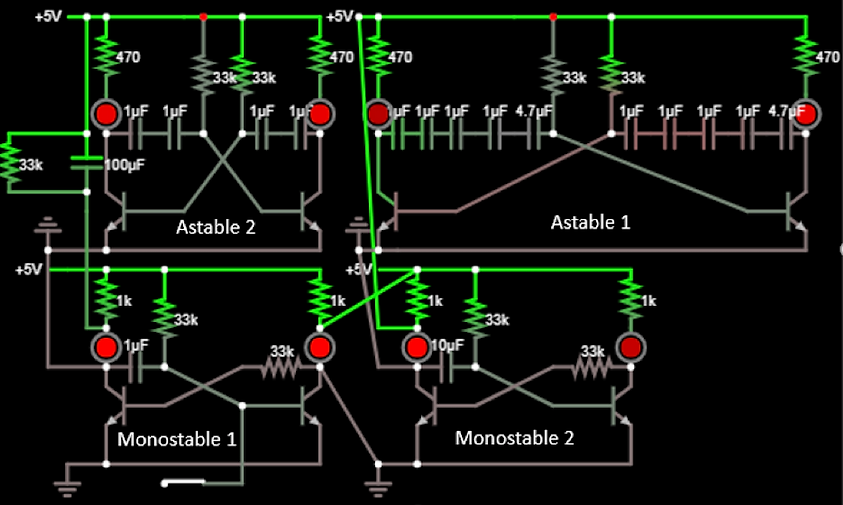ABOUT THIS PROJECT
This project delves into the application of circuits and physics concepts in solving real-life problems. The problem being solved here is "In a regular Home setting , how can a visitor alert a host that he/she has arrived?"
The solution is as simple as an "Electronic doorbell". The goal of this project is to set up a purely electronic doorbell that mimics the typical house doorbell "ding-dong" tone. A resistor and Capacitor combination, known as an R-C oscillator is the theorotical foundation of the project.
.jpg)
MORE ABOUT THE R-C ELECTRONIC DOORBELL
How We Got Here
Eight (8) Transistors
Eight (8) LEDs
Three (3) Breadboards
One (1) Push Button
Resistors – Nine (9) 33kΩ, Four (4) 1kΩ, Four (4) 470kΩ
Capacitors – Thirteen (13) 1mF,Two (2)4.7mF, One (1)10mF, One (1)100mF
Analogue Discovery Kit
Jumper cables
WaveForms application
AUX Cable
Beats Pill+(Product)RED
SCHEMATIC DIAGRAM

METHODOLOGY
The circuit consists of two Monostable Mulitvibrators and two Astable Multivibrators. The monostable multivibrators act as switches for the two different tones whiles the astable multivibrators are used to generate the frequency of the two tones based on capacitance values.
A five (5) volts D.C supply is used to power monostable 1. Next, the voltage across the monostable 1’s quasi-stable LED is used to power astable 1. Thus, when the push button is pressed, monostable 1 switch to quasi-stable state and the frequency (ding tone) of the alternating voltage produced by astable 1, which gets a DC voltage supply from the quasi stable state of the monostable 1, is played through the speaker output.
In order to create a two-tone door bell, a second set of monostable and astable multivibrators is needed. The voltage supplied to monostable 2 is tapped across monostable 1’s stable state LED and the voltage across monostable 2’s quasi-stable LED is used to power astable 2. Hence, when the push button is released and monostable 1 is back to its stable state, the input voltage is fed into monostable 2. This causes monostable 2 to switch to its quasi stable state, and in that moment, the frequency (“dong” tone) of the alternating voltage produced by astable 2 is played through the speaker output, just like in the instance of the first monostable-astable pair. The monostable 2 then switches from quasi stable to stable state once the capacitor on the quasi stable side gets charged.
Project Report : https://www.mediafire.com/file/7r06h2j9bhm76w4/Physics_Final_Project_.docx/file

OUR TEAM
Get to Know Us

EDINAM KLUTSE
Ashesi University College Computer Engineering, Class of 2021

TIMOTHY CHARLES-DEBRAH
Ashesi University College Computer Engineering, Class of 2021

OPANIN AKUFFO
Ashesi University College Computer Engineering, Class of 2021

RONNY PANFORD
Ashesi University College Mechanical Engineering, Class of 2021
